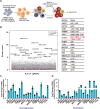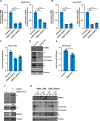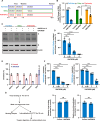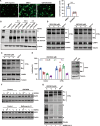UNC0638 inhibits SARS-CoV-2 entry by blocking cathepsin L maturation
- PMID: 40530850
- PMCID: PMC12282183
- DOI: 10.1128/jvi.00741-25
UNC0638 inhibits SARS-CoV-2 entry by blocking cathepsin L maturation
Abstract
Since the outbreak of SARS-CoV-2, viral mutations have posed significant challenges in identifying therapeutic targets and developing broad-spectrum antiviral drugs. Post-translational modifications of genes involved in interferon production and signaling pathways play a crucial role in regulating interferon responses. In this study, we employed CRISPR-Cas9 screening based on adenine base editors to investigate functional amino acids in 1,278 innate immune-related genes. This approach, which converts A-T base pairs into G-C base pairs to probe the functional importance of specific amino acids, allowed us to identify 17 vital factors involved in SARS-CoV-2 infection. Among the candidate genes, genetic knockdown of EHMT2 exhibited the strongest antiviral effect. Further analysis revealed that UNC0638, a selective inhibitor of EHMT2, significantly reduced the endosomal entry of SARS-CoV-2 in pseudovirus assays. The observed inhibitory effect was consistently observed across multiple SARS-CoV-2 variants, including Alpha, Beta, Delta, and Omicron. Mechanistically, UNC0638 reduced mature cathepsin L (CTSL) levels, impairing the proteolytic cleavage of SARS-CoV-2 spike protein and subsequent membrane fusion, a critical step for viral entry. Our findings uncover EHMT2 as a host dependency factor and reveal the antiviral mechanism of EHMT2 inhibitors through CTSL maturation blockade. These results advance the understanding of host factors in SARS-CoV-2 infection and provide a strategic framework for developing host-targeted antiviral therapies.IMPORTANCEIn this study, we demonstrated that knockdown or knockout of EHMT2 inhibited SARS-CoV-2 infection, and inhibitors of EHMT2, including UNC0638, UNC0642, and BIX01294 showed similar restrictive effects. Mechanistically, the EHMT2 inhibitor UNC0638 restricts spike-mediated cell entry by inhibiting the maturation of CTSL, a critical protease required for SARS-CoV-2 entry via the endosomal pathway. Importantly, CTSL is not only essential for SARS-CoV-2 but also plays a key role in the entry of other coronaviruses that utilize similar pathways. Therefore, EHMT2 inhibitors could have broader applications as pan-coronavirus therapeutic agents.
Keywords: EHMT2; SARS-CoV-2; UNC0638; cathepsin L; viral entry.
Conflict of interest statement
The authors declare no conflict of interest.
Figures







Similar articles
-
The Proton-Activated Chloride Channel Inhibits SARS-CoV-2 Spike Protein-Mediated Viral Entry Through the Endosomal Pathway.J Cell Physiol. 2025 Jul;240(7):e70063. doi: 10.1002/jcp.70063. J Cell Physiol. 2025. PMID: 40696792
-
Determinants of susceptibility to SARS-CoV-2 infection in murine ACE2.J Virol. 2025 Jun 17;99(6):e0054325. doi: 10.1128/jvi.00543-25. Epub 2025 May 12. J Virol. 2025. PMID: 40353671 Free PMC article.
-
Synthetic host defense peptide inhibits SARS-CoV-2 replication in vitro.Antimicrob Agents Chemother. 2025 Aug 6;69(8):e0170024. doi: 10.1128/aac.01700-24. Epub 2025 Jun 23. Antimicrob Agents Chemother. 2025. PMID: 40548715 Free PMC article.
-
Antibody tests for identification of current and past infection with SARS-CoV-2.Cochrane Database Syst Rev. 2022 Nov 17;11(11):CD013652. doi: 10.1002/14651858.CD013652.pub2. Cochrane Database Syst Rev. 2022. PMID: 36394900 Free PMC article.
-
Measures implemented in the school setting to contain the COVID-19 pandemic.Cochrane Database Syst Rev. 2022 Jan 17;1(1):CD015029. doi: 10.1002/14651858.CD015029. Cochrane Database Syst Rev. 2022. Update in: Cochrane Database Syst Rev. 2024 May 2;5:CD015029. doi: 10.1002/14651858.CD015029.pub2. PMID: 35037252 Free PMC article. Updated.
References
-
- Guery B, Poissy J, el Mansouf L, Séjourné C, Ettahar N, Lemaire X, Vuotto F, Goffard A, Behillil S, Enouf V, Caro V, Mailles A, Che D, Manuguerra J-C, Mathieu D, Fontanet A, van der Werf S, MERS-CoV study group . 2013. Clinical features and viral diagnosis of two cases of infection with middle east respiratory syndrome coronavirus: a report of nosocomial transmission. Lancet 381:2265–2272. doi: 10.1016/S0140-6736(13)60982-4 - DOI - PMC - PubMed
MeSH terms
Substances
LinkOut - more resources
Full Text Sources
Miscellaneous

